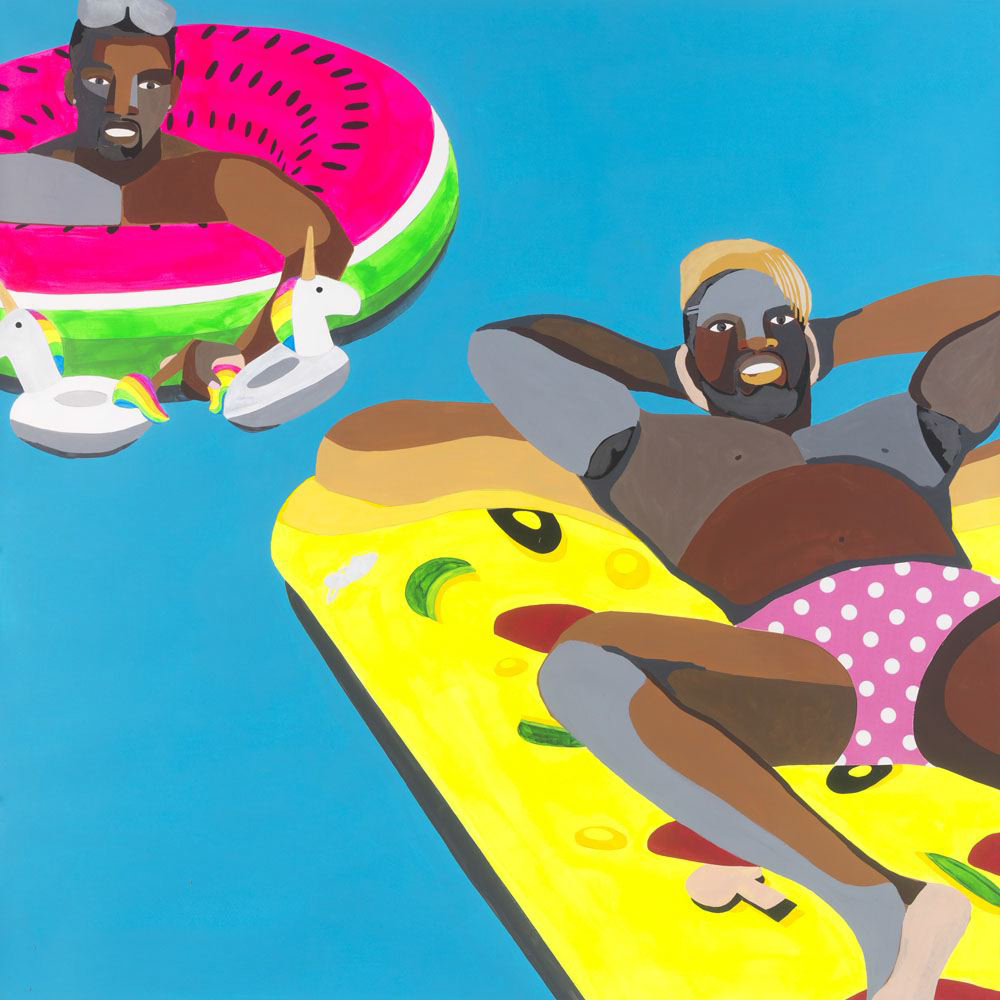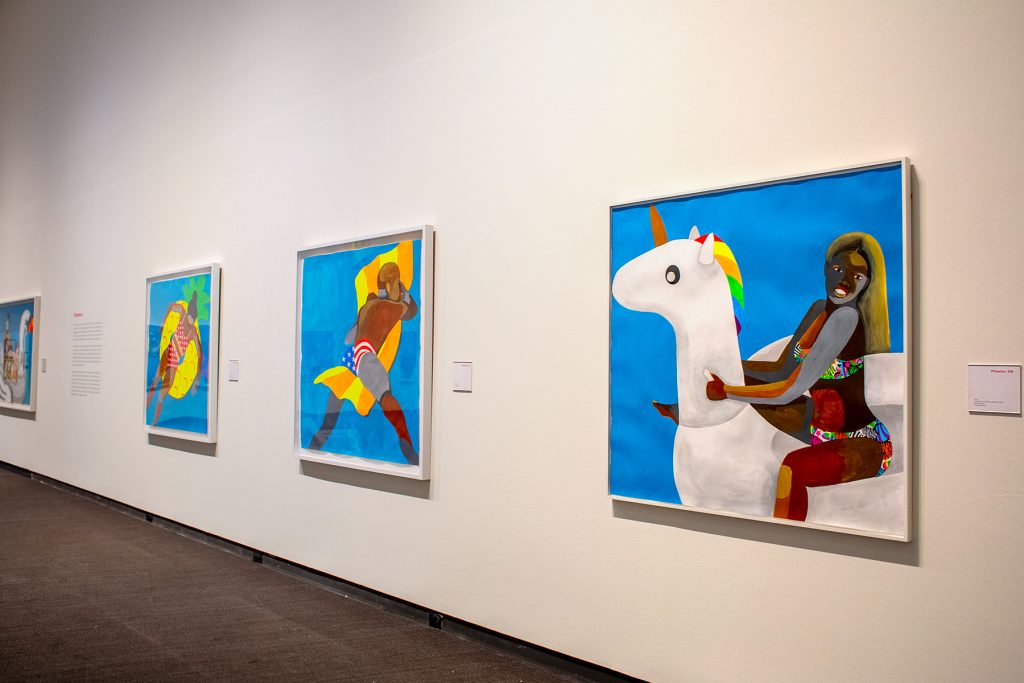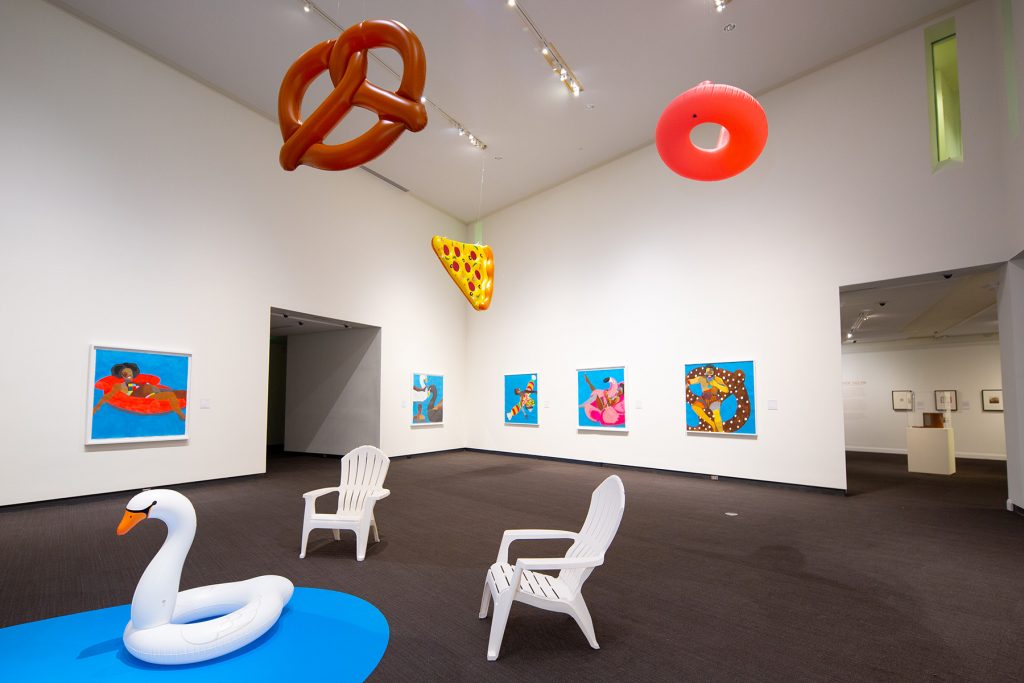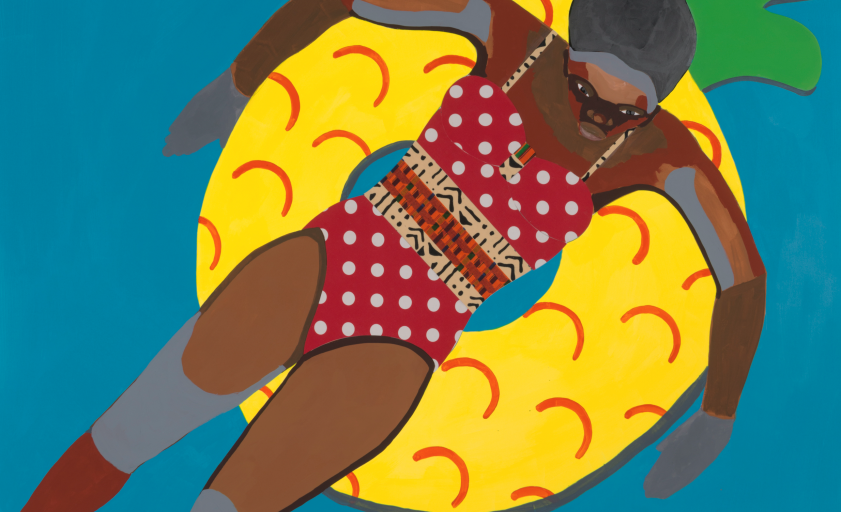by Sabrina Hughes
“I didn’t know that that work was even radical in the way that I see it as being radical now until I started to have a conversation with people—even black people—who thought that my work was “positive.”
Derrick Adams, Artnet News, February 5, 2020.
Derrick Adams: Buoyant is on its last tour stop at the Museum of Fine Arts, St. Petersburg through November 29, 2020. The exhibition was initially conceived by the Hudson Valley Museum and curated by James E. Bartlett, founder of Open Art and former Executive Director of the Museum of Contemporary African Diasporan Arts, in Brooklyn, and Laura Vookles, Chair of the Hudson River Museum’s Curatorial Department.

Photo: Courtesy of the Museum of Fine Arts, St. Petersburg.
On entering, the exhibition may strike a viewer as many things: joyful, fun, playful, enticing, or whimsical. The twelve large-scale paintings in the exhibition are an explosion of neon and novelty. Radical may not be the first word that comes to mind upon visiting the exhibition when the subject matter, groups of people and individuals relaxing on novelty pool floats, is so patently ordinary.
The Floaters series was created over a span of three years (2016-2019). This is a rare opportunity to see works on loan from private collections, and to see some of the Floaters together as a group, which creates a much different feeling than would seeing any one on its own. Walking into the gallery is walking into a space occupied by paintings of African Americans. Part of the impact of the exhibition is that it highlights how rarely we see representations—in art or popular media—of Black people simply existing. This everyday reality of Black life in America suffers from erasure by omission.

In relation to the picture planes of all of the Floaters, the viewer is left rather floating themselves. With the exception of one, the backgrounds of the paintings are one solid shade of blue (one painting has a darker blue at the top that seems to denote the difference between sky and water, the only horizon line in the gallery). The paintings are acrylic on paper, so there are ripples in the paper most noticeable in the blue background as the paper absorbed the paint and dried. The ripples and the occasional variations in the blue field—not a different color, but from more or less paint on the brush—enhance the suggestion of water and gentle motion.
Figures are anchored to their novelty pool floats, but beyond that there are no clues to what kind of space they occupy, other than that it’s water. Without a horizon line, the viewer is left in an uncertain space. Some of the figures are looking out of their space, making eye contact with viewers while many others are engaged with other figures or are simply looking elsewhere.

Photo: Courtesy of the Museum of Fine Arts, St. Petersburg.
The swimsuits of each figure are collage elements of different fabric, adding another visual flourish to the already dazzling paintings.
In an interview with Charles Moore for artnet news that I’ll refer to several times, Derrick Adams uses the phrase “Black radical imagination” which, as he sees it, can be a tool to create the future. It is worth exploring this idea so we can fully appreciate how radical these day-glo spaces inhabited by patchwork figures are.
Representation reflects and creates reality. We have seen this thought repeated a lot over the last decade or so—representation matters. Everyone wants to be able to see themselves and their possibilities reflected in the popular media they consume. When Adams conceived the Floaters series in 2015, he searched Instagram for #floaties and the algorithm returned only pictures of white people. In this instance, the representation failed to align with the reality that he had experienced.

In further research, Adams found inspiration in an Ebony feature from June 1967 of Coretta and Dr. Martin Luther King, Jr. on a tropical escape to Ocho Rios, Jamaica (also included in the exhibition). While the article makes clear that this is not a vacation (King wanted a month in a place without a phone to write his book Where Do We Go from Here?), the photo essay is almost exclusively comprised of images showing Dr. King at rest: walking on the beach, relaxing in the pool, having breakfast on the balcony in his robe and slippers, reading the newspaper in bed. This fascinating editorial shows a seldom-seen side of Dr. King, but also shows what is necessary to fuel his public acts in the struggle for equal civil rights: rest, quiet, isolation, time to think and to put thoughts in order. Time and space to just exist.
It’s worth quoting Adams at length because his intent with the Floaters series was to depict Black people at rest, similar to how Dr. King had been photographed for Ebony.

Photo: Courtesy of the Museum of Fine Arts, St. Petersburg.
“What I love the most is when I’m at an event or a party at someone’s house and I look around and everyone in the room is doing something. It’s all Black people doing all these amazing things and I’m like, wow, this is great. And I say to myself, this is what we should be making work about, this type of atmosphere. Young Black people should see that there are very normal, very consistent spaces like these—regardless of what’s happening in the news, regardless of what’s happening on social media. With all the conflicts that we’re having, we’re still finding the time. And not everyone in this room has money! These aren’t people who are all well off!
That’s what I’m thinking about in my studio: What can I reveal that has not been shown? And it always goes back to the simplest of things, like normalcy. Black people—not entertaining, just being, living. Letting people deal with that as reality. We’re sitting on this pool float. We’re thinking about life. We’re thinking about nothing. We don’t have to think about something every day. It’s a real human experience not to ponder on things constantly.”
The paintings that resonated most with me were both paintings of women. I’ll describe them but they’re not reproduced here, so you’ll have to go to the exhibition to see them for yourself.
Floater #28 depicts a woman on a white unicorn float. Her bathing suit is neon animal print with hearts and stars, like a Lisa Frank notebook. She looks out of her space and is smiling. Though the blue fields that the figures float on often have the effect of suggesting water through the variations in paint application, most of the geometric planes that comprise the figures are more even in tone—less painterly, more hard-edge. This figure is different. The paint application on her legs and abdomen create a variation in tone within the planes that most of the other figures don’t exhibit. It’s like seeing the natural variation in skin tone across different parts of someone’s body. Adams has also employed the grey-tone paint—usually reserved for the parts of the figures bodies that are underwater—on the figure’s arm and face that couldn’t be the only part under the water if the rest of her is not. It’s the kind of variation that feels like improvisation on the theme. It’s just different enough to have made me stop and look a lot more closely.
Representations like Floaters reflect one reality experienced by Black folks in America, one that aligns with the experience of love, community, family, and just living life. It hints at another reality from the not-so-distant past—the reality that all-Black spaces were backed by apartheid laws and violently enforced by police and mercenary groups. Pools and beaches were sites of contestation. Here in St. Petersburg, the beaches downtown were segregated. From Spa Beach north was designated whites only. The beaches for African Americans were South Mole at what is now Demen’s Landing and Lassing Park.
The subject matter of the paintings contain the tension of present and past, even while Adams is trying to create a future where celebrations of everyday Black life are more commonplace.
We see Black lives snuffed out on live Facebook broadcasts. We see representations of Black Americans working, struggling, mourning. We see them relative to the white supremacist political and economic system that their kidnapped ancestors were forced to build, and that largely controls what type of images are disseminated in the public sphere. It is rare to see representations of Black people resting. Images of Black bodies at rest are radical.

Photo: Courtesy of the Museum of Fine Arts, St. Petersburg.
Floater #17 portrays a pregnant woman lounging on a hot pink float. I imagine the buoyancy of her body, with or without the float, is a welcome relief from gravity’s pull on the extra bulk of her body carrying a baby. Black women experience overlapping oppression of misogyny and racism, represented by the term misogynoir. As a class, they have always been expected to work (when white women may have been homemakers, Black women may have been their maids or nannies) and have had the highest labor force participation among all women for years. The United States has a dark history of sterilizing Black women without their consent throughout the 20th century. Yet look back earlier, when African Americans were enslaved and performing forced labor, and Black women’s bodies were commodities that grew the labor force.
Artists are worldbuilders. By making these paintings, Adams populates our world with many more images of Black leisure. Adams realizes the power of the artist to create reality—to create the world in images so that later people can create it through action. If you want an action to succeed, you have to be able to imagine it has happened, and then imagine what happens next. Adams invites viewers to co-create a future where images like this aren’t “positive” in comparison to other pictures, where all aspects of Black life aren’t adjunct to their white counterparts, presented as the default.
The term radical seems to be used with such frequency that the impact of the word has faded. From radical feminism to radical self-care, radical honesty to the radical left, radical is just as often used by Instagram influencers to sell protein powder as in any political reformist sense. We live in a radical-saturated world. Invoking Black radical imagination asks for a rethinking of all assumptions about Black life in America, from the roots up. Ask why things are the way they are and why they seem unchangeable. And then imagine what systems need to be torn down to their foundations and rebuilt differently. In 2020 conversations about prison abolition have entered mainstream political discourse. This is radical imagination at work.
As I’m writing this review, the verdict in Louisville has just come in. Nobody is going to be criminally charged for Breonna Taylor’s murder, though one officer is being charged for endangering the lives of her white neighbors. I’m thinking about Breonna who was not only at home, but was sleeping, literally at rest, when she was killed. Imagine if this had had a different outcome. Imagine what needs to be torn down and rebuilt to ensure future Black lives are valued and protected. I’m also thinking how even though Adams’ intent was to show Black joy and play and people just existing, it seems that there is no neutral in the representation of African Americans. It becomes political as soon as it enters the public because Black people just existing is a radical and revolutionary act. Unless we are part of the communities that Adams is talking about, we may not see the experience that he’s talking about. Black people just living, just being. Black figures at rest. Black people not othered by the implicit or explicit comparison to whiteness. Being in the gallery with so many Floaters makes me wonder if it’s a pool, how enormous the pool must be to hold the figures, the floats, and to still not see the horizon. Are we floating with them? Part of the party? Or interlopers?
Related Exhibition Programming

PANEL DISCUSSION: AFRICAN AMERICAN LEISURE IN THE SUNSHINE STATE & BEYOND WITH DERRICK ADAMS
October 15, 2020, 6:30-8 pm
Free for members, and $10 for not-yet-members.
An online conversation featuring Derrick Adams, Dr. Gretchen Sorin, author of Driving While Black: African American Travel and the Road to Civil Rights, and Cynthia Wilson-Graham, co-author of Remembering Paradise Park: Tourism and Segregation in Silver Springs. The discussion will be moderated by MFA Curator of Contemporary Art Katherine Pill.
BLACK FANTASTIC, BUOYANT AND BOLD: ART’S WAYS OF LEVITATING OVER THE WEIGHT OF THE WORLD WITH AUTHOR TENEA D. JOHNSON
October 22, 2020, 6-7 pm
Free for members, and $10 for not-yet-members
Author Tenea D. Johnson will read joy-centered selections from her latest book, Blueprints for Better Worlds (May 2020)as well as the forthcoming collection, Broken Fevers.
POETRY AND SPOKEN WORD WITH DENZEL JOHNSON-GREEN
October 25, 2020, 3-4 pm
Free for members, and $20 for not-yet-members.
Join poet and author Denzel Johnson-Green in the time-honored tradition of utilizing spoken word and poetry to both raise awareness of, and develop mechanisms for addressing, the world around us.
About the author:
Bay Art Files contributor Sabrina Hughes holds an M.A. in Art History from the University of South Florida with a focus on the History of Photography. Hughes has worked at the National Gallery of Art and the Museum of Fine Arts, St. Petersburg and is an adjunct instructor at USF and is the founder and principal of photoxo, a personal archiving service specializing in helping people preserve their family photos. She has an ongoing curatorial project, Picurious, which invests abandoned slides with new life. Follow her on Instagram @sabrinahughes for selfies, hiking, and dogs, and @thepicurious for vintage photos.
